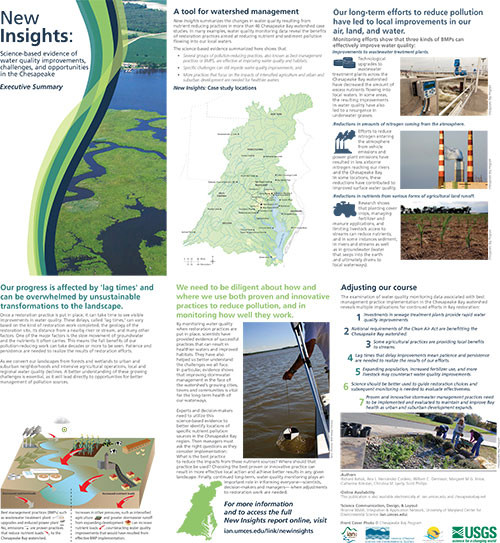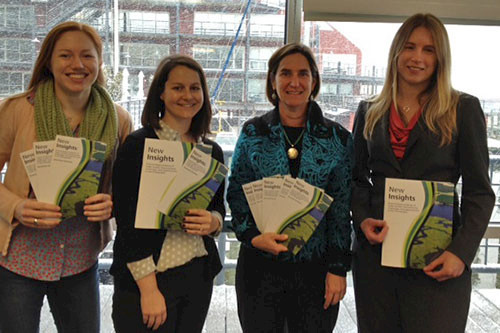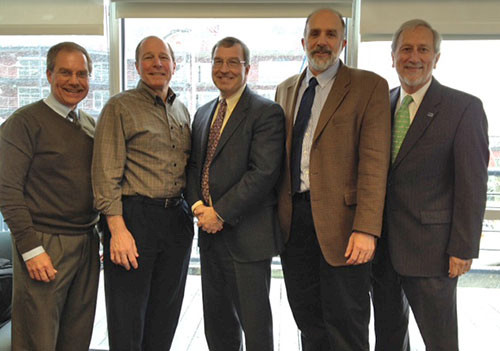New Insights report: Converting geeky science into understandable stories
Bill Dennison ·In collaboration with the Chesapeake Bay Program and US Geological Survey (USGS), we released a report entitled "New Insights: Science-based evidence of water quality improvements, challenges, and opportunities in the Chesapeake". The release was conducted at the Chesapeake Bay Program in Annapolis on 25 February 2014 . We produced a 52 pp. full color report and a small trifold executive summary to accompany the full report.

The process for completing this assessment of what was working and what was not working regarding Chesapeake Bay restoration had its genesis in an analysis of monitoring strategies that was conducted several years ago. We came to the realization that we had not devoted enough effort interpreting the monitoring data that we had been collecting. So the two relevant Chesapeake Bay Program workgroups, the Tidal Monitoring and Analysis Workgroup (TMAW) and the Non-Tidal Analysis Workgroup (NTAW) set upon a journey to synthesize the lessons learned using monitoring data. In the end, forty case studies from all around the Chesapeake watershed were included. The respective tidal and nontidal workgroup coordinators, Liza Hernandez and Katie Foreman, both University of Maryland Center for Environmental Science @ Chesapeake Bay Program data analysts, set out to collect the case studies and assemble the data used in the report. Liza and Katie did this in addition to their full time jobs of coordinating their workgroups, which prevented the task from proceeding swiftly.
Then last year when Katie left the Chesapeake after five years to take a position in Portland, Oregon, we had an opportunity to temporarily replace her with a new person without the day-to-day responsibilities who could focus on the 'lessons learned' report. This person was Christina Lyerly and she worked with Liza, Scott Phillips from USGS, and myself to assemble and edit the contributions from 31 authors. We also recruited one of the talented Integration and Application Network Science Communicators, Brianne Walsh, to produce the final product. We were able to produce a draft document which came up with seven lessons: three in the 'What's working' category, two in the 'Challenges' category (= What's NOT working) and two in the 'Opportunities' category. These seven lessons are the following:
What's working:
- Upgrades in both nitrogen and phosphorus waste water treatment result in rapid local water quality improvements.
- Improvements in air quality lead to reductions in atmospheric nitrogen deposition.
- Reductions of agricultural nutrient sources result in improved stream water quality.
Challenges:
- Many practices provide initial water quality improvements in runoff, however, full benefits to stream conditions can be delayed.
- Improvements in water quality can be counteracted by changes in nutrient sources and land-use practices.
Opportunities:
- Observable water quality responses are more likely to occur if A) location-specific sources of pollution are identified and B) targeted practices are implemented.
- An array of practices to promote stormwater infiltration and retention are needed in urban and suburban areas.
The report ended up being 52 pp. long, and we decided to create a short executive summary in the hopes of reaching a broader audience than the resource managers who were targeted in the full report. We teamed up with the communications group at the Chesapeake Bay Program to mock up this trifold executive summary. This group included Margaret Enloe, Catherine Krikstan, and Rich Batiuk, Liza Hernandez, Scott Phillips and Christina Lyerly.

The first thing we did was recast the title, converting our working title "Lessons learned Chesapeake Bay restoration efforts: Understanding nutrient reduction activities in improving water quality" into the final title "New Insights: Science-based evidence of water quality improvements, challenges, and opportunities in the Chesapeake". We also converted the seven lessons into the following three statements using personal pronouns to create a more personal connection:
- Our long-term efforts to reduce pollution have led to local improvements in our air, land, and water.
- Our progress is affected by 'lag times' and can be overwhelmed by unsustainable transformations to the landscapes.
- We need to be diligent about how and where we use both proven and innovative practices to reduce pollution, and in monitoring how well they work.
In addition, the seven lessons were recast in the following manner to broaden our reach to non-technical people:
What's working:
- Investments in sewage treatment plants provide rapid water quality improvements.
- National requirements of the Clean Air Act are benefitting the Chesapeake Bay watershed.
- Some agricultural practices are providing local benefits to streams.
Challenges:
- Lag times that delay improvements mean patience and persistence are needed to realize the results of our efforts.
- Expanding population, increased fertilizer use, and more livestock may counteract water quality improvements.
Opportunities:
- Science should be better used to guide restoration choices and subsequent monitoring us needed to evaluate effectiveness.
- Proven and innovative stormwater management practices need to be implemented and evaluated to maintain and improve Bay health as urban and suburban development expands.
Comparing the original title with the final title and the original seven lessons learned into the final list provides a 'before and after' comparison of geeky science vs. more approachable language for a broader audience. It also illustrates the importance of engaging with non-specialist communicators to develop appropriate language.
At the press conference, Nick DiPasquale, Director of the Chesapeake Bay Program, introduced the report and stressed "patience and persistence" are needed in Chesapeake restoration. Don Boesch, President of UMCES, talked about the importance of relying on monitoring data to assess our progress and that we needed to have "informed patience". I talked about the major elements of the report, and added the word "perspiration" to "patience and persistence", referring to the work we have ahead. Scott Phillips talked about lag times and the targeting of innovative practices that we need to incorporate into our future actions. Rich Batiuk talked about how world class models have been developed for the Chesapeake Bay Program, but how important it is to have monitoring data to really know how we are doing.

Immediately following the press conference, Don Boesch and I attended the monthly BayStat meeting with Maryland Governor Martin O'Malley. In briefing the Governor about the New Insights report, he asked to see the full report as well as the executive summary. The Governor studied the report and then asked for twenty copies of the full report to take along to his meeting with newly elected Virginia Governor Terry McAuliffe on the following day. We interpreted that as a good sign that this report would halo guide restoration priorities for the two states most intimately involved with Chesapeake Bay.
About the author
Bill Dennison

Dr. Bill Dennison is a Professor of Marine Science and Interim President at the University of Maryland Center for Environmental Science (UMCES).